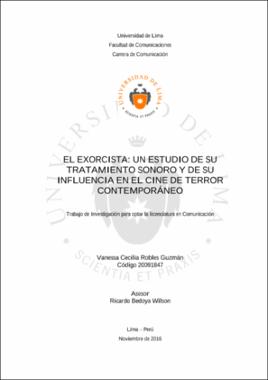| dc.contributor.advisor | Bedoya Wilson, Ricardo Humberto | |
| dc.contributor.author | Robles Guzmán, Vanessa Cecilia | |
| dc.date.accessioned | 2017-05-03T17:46:16Z | |
| dc.date.available | 2017-05-03T17:46:16Z | |
| dc.date.issued | 2016 | |
| dc.identifier.citation | Robles Guzmán, V. C. (2016). El exorcista: un estudio de su tratamiento sonoro y de su influencia en el cine de terror contemporáneo (trabajo de investigación para optar el título profesional de Licenciada en Comunicación). Universidad de Lima. | es_PE |
| dc.identifier.uri | https://hdl.handle.net/20.500.12724/3594 | |
| dc.description.abstract | El Exorcista, una película del género de terror dirigida por William
Friedkin en 1973, no solo es un clásico del género; también es un referente para el cine de horror realizado después. Ello se debe a su tratamiento de asuntos que resultaban inéditos para el género, como la sexualidad infantil, y a las características de la representación del proceso de transformación física de una niña poseída, así como al
diseño de su banda sonora y de todos sus componentes: la palabra, los ruidos o efectos sonoros, las atmósferas creadas con ellos, la música y el silencio. Todos ellos se orientan a la creación de un clima de horror visceral, donde el miedo provocado por el género convive con el disgusto, el asco y la repulsión causados por los elementos de la representación fílmica. Este artículo describe e interpreta la singularidad de ese tratamiento sonoro de El Exorcista, apuntando aquello que ha resultado influyente en el curso de la historia del género de terror. | es_PE |
| dc.description.abstract | The Exorcist, a film of horror genre directed by William Friedkin in 1973, is not only a classic of the genre; it is also a reference to horror films made later. This is due to its treatment of issues that were unprecedented for the genre, such as infantile sexuality, and the characteristics of the representation of the process of physical transformation of a possessed girl, and the design of the soundtrack and all its components: voice, sound effects, atmospheres created with them, music and silence. They are aimed at creating a climate of visceral horror, where fear caused by gender coexists with disgust, repugnance and repulsion caused by the elements of filmic representation. This article describes and interprets the uniqueness of the sound treatment of The Exorcist, pointing what has been influential in the course of the history of the horror genre. | en_EN |
| dc.description.uri | Trabajo de investigación | es_PE |
| dc.format | application/pdf | |
| dc.language.iso | spa | |
| dc.publisher | Universidad de Lima | |
| dc.rights | info:eu-repo/semantics/openAccess | * |
| dc.rights.uri | https://creativecommons.org/licenses/by-nc-sa/4.0/ | * |
| dc.source | Universidad de Lima | es_PE |
| dc.source | Repositorio Institucional - Ulima | es_PE |
| dc.subject | The exorcist (Motion Picture film) | en_EN |
| dc.subject | Motion pictures-Sound effects | en_EN |
| dc.subject | Terror in motion pictures | en_EN |
| dc.subject | Películas de terror | es_PE |
| dc.subject | El exorcista (Película cinematográfica) | es_PE |
| dc.subject | Cine-Efectos sonoros | es_PE |
| dc.title | El exorcista: un estudio de su tratamiento sonoro y de su influencia en el cine de terror contemporáneo | es_PE |
| dc.type | info:eu-repo/semantics/bachelorThesis | |
| thesis.degree.level | Título Profesional | es_PE |
| thesis.degree.discipline | Comunicación | es_PE |
| thesis.degree.grantor | Universidad de Lima. Escuela Universitaria de Humanidades. Facultad de Comunicación. Carrera de Comunicación | es_PE |
| dc.publisher.country | PE | |
| dc.type.other | Trabajo de investigación | |
| thesis.degree.name | Licenciada en Comunicación | es_PE |
| renati.advisor.orcid | https://orcid.org/0000-0003-2780-6648 | |
| renati.discipline | 322026 | |
| renati.level | https://purl.org/pe-repo/renati/level#tituloProfesional | * |
| renati.advisor.dni | 07786983 | |
| renati.type | https://purl.org/pe-repo/renati/type#trabajoDeInvestigacion | * |
| dc.subject.ocde | https://purl.org/pe-repo/ocde/ford#5.08.00 | |
| ulima.cat | OI | |


